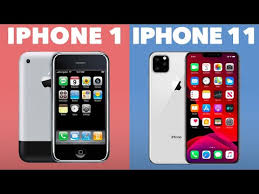The evolution of the iPhone: from iPhone to iPhone 11

The iPhone 11 released on September 20, 2019, showing true progression in comparison to the first iPhone in 2007. The first generation of the iPhone shows a small 3.5-inch screen. Throughout the phone’s evolution, the screen size grew with the inclusion of plus-size options. The iPhone 11, 11 Pro and Pro Max range in size from 5.8-6.5 inches. Although two completely different models, they represent Apple’s evolution and the iPhone’s progression as a whole.
September 30, 2019
Released on September 20, the iPhone 11 and its two variants (the Pro and the Pro Max) celebrate twelve years of the iPhone and its impact on the smartphone market. With each yearly release of a new phone, developer Apple applies new and innovative technologies to each model.
The current iPhone 11 introduces major innovations such as a new camera system and an A13 Bionic chip allowing for 4 additional hours of battery life. The iPhone 11 model uses a 12mp double camera system with a wide and ultra-wide camera. In comparison, the iPhone 11 Pro and Pro Max offer an additional Telephoto camera used for distant subjects and portraits; and while all these features do signal an exciting shift forward for Apple, purchasers should keep in mind that the common features on their phones exist due to over a decade of iPhones innovating the smartphone market.
iPhone First Generation
When the first iPhone released 12 years ago on June 29, 2007 this yearly tradition commenced. MacWorld, as Apple was called at the time, announced to the public its “reinventing of the phone” foreshadowing the future of the smartphone.
“The iPhone changed the concept of what it means to have a phone. In today’s society, the iPhone is a symbol of status. Usually, instead of being desired for the best specs, it is a coveted device that is mostly desired for what it means, not necessarily what it does all the time,” senior Emily Wagner said.
The first generation of the iPhone’s innovations included Wi-Fi (a new concept for internet access in 2007), 2G data, a headphone jack, a camera, and Bluetooth. Regarding applications, the iPhone introduced GPS and a photo/video viewing application, birthing the concept of downloading apps, preceding the modern Apple store.
iPhone 2 (iPhone 3G)
After a successful inaugural year, the concept of 3G data introduced with the iPhone 2 (the iPhone 3G), released on June 11, 2008. The significantly lower price of $199 drew customers in, as well as advances like the Apple Store, the Safari internet browser and faster download speeds.
As the 3G increased in popularity, rising demand required a new version to release. Released June 19, 2009, the iPhone 3GS brought a 3-megapixel autofocusing camera, hands-free voice control, video recording and longer battery life (9 hours on wi-fi, 30 hours for music).
The iPhone 4
Continuing tradition, Apple launched the first stainless steel iPhone 4, on June 24, 2010. With a 5-megapixel rear camera (shooting with LED flash), the emphasis of the Retina Display heavily influenced the phone, producing the clearest screen in iPhone history. In addition to the new material, a wi-fi based version of Facetime debuted. The idea of face to face interaction, while taken for granted now, changed communication forever upon its debut.
The iPhone 4s
The iPhone 4s launched on October 14, 2011. The introduction of the artificial intelligence Siri increased the iPhone’s accessibility by allowing users to call, text, set alarms and browse the internet solely with the AI; this iPhone also marked the birth of iCloud, Apple’s digital storage service used to store photos, videos and more.
The iPhone 5, 5s and 5c
The following year saw the release of the iPhone 5, which brought minor improvements to Siri, Apple’s navigation, and cellular network-based Facetime. The next models, the 5C and 5s, brought forth minor innovations in comparison to the iPhone 5. The iPhone 5c launched September 20, 2013 and introduced a variety of new colors and a polycarbonate shell. The 5s showed advancements in the retina display and introduced an 8-megapixel camera with a two-tone flash, improving overall photo quality.
The iPhone 6(s) and 6(s) Plus
The iPhone 6 initiated a new option for users launching in September of 2014. The phone introduced the concept of a plus model with a larger screen and increased storage. This concept would continue to influence Apple, encouraging them with feedback on the plus-size models. The next models—The iPhone 6s and 6s plus— (both released September of the next year) followed, both with a 12-megapixel camera recording 4k video and a 5-megapixel front-facing camera; 6 months after release, Apple decided to release yet another phone.
The iPhone SE
The iPhone SE debuted in March 2016; in the eyes of users, the phone provided the best budget for a smartphone at the time, selling at a low price of $350. With innovations in the A9 core processor, the phone provided 4k video streaming, longer battery life, faster wi-fi, and a 12-megapixel camera with two-tone flash. Unfortunately, Apple discontinued the phone after only a year, upsetting users.
The iPhone 7 and 7 Plus
After the SE discontinued, Apple fixed their mistakes with the iPhone 7and iPhone 7 Plus released on September 16, 2016. The model lacked a headphone jack changing the shape of the headphone’s adapter from circular to rectangular, fitting the charging port. In addition, the phone displayed larger stereo speakers and added portrait mode to the camera application.
“The lack of a headphone jack made it harder to listen to music and required people to buy another pair of completely different earbuds,” freshman Claire Scfadi said.
The iPhone 8 and 8 Plus
The next phone, iPhone 8 and 8 plus skipped an “S” version of the iPhone and released on September 22, 2019. It featured glass bodies, allowing for a new system of inductive-charging. Inductive or wireless charging did not require plugging in the phone. It instead allows for using a portable device to charge. As of now, the phone continues to sell as a cheaper option in comparison to the older iPhone 7 and 7 Plus models.
The iPhone X
Skipping an iPhone 9, and breaking the year tradition once again, the iPhone X released on November 3, 2017. The updated phone dissolved the home button and implemented face ID technology. Otherwise, the phone’s accessibility and innovations lacked, generating low sales. Only selling for a year, it discontinued alternate versions produced the next year.
The iPhone XR, XS, and XS Max
Maintaining the absence of the home button and producing an increase in storage, the iPhone XS and XS Max debuted on September 21, 2018. Both models offer up to 512 GB of storage, a once impossible feature. A third model, the iPhone XR, debuted October 26, 2018: Apple designed the phone to provide a budget-friendly option for Apple users wanting an X model. The phone consists of numerous similarities to the XS and XS Max, with the exception of minor audio controls, bug fixes, and color options
Upon the debut of the iPhone 11, Apple’s constant evolution accumulates with breakthroughs in technology from cameras, battery life, storage and more. The one factor that remains the same, however, relies upon the embrace of change. Without constant creative modifications, the modern smartphone that users crave and love would cease to exist.

















Alisha Ross • Mar 11, 2020 at 12:45 AM
I think this is one of the most important info for me. And i’m glad reading your article. But should remark on few general things, The website style is great, the articles is really excellent : D. Good job, cheers
Regards